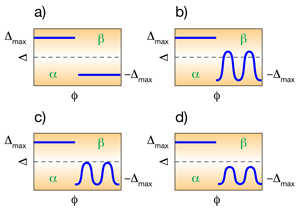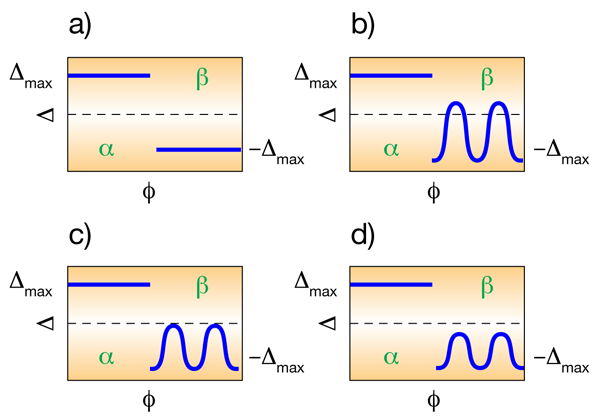Nodes to the grindstone
Materials become superconductors when charge carriers pair up; this pairing is stabilized by an energy gap, the energy cost for creating single-particle excitations. In any new class of superconductors, the momentum-space structure of this energy gap (or superconducting order parameter) is generally considered to be one of the most important clues to the nature of the pairing mechanism. Determining the order parameter is rarely straightforward, and historically, e.g., in the high-temperature cuprate superconductors, many different types of experiments had to be analyzed and compared before a consensus was achieved. It is therefore not surprising that, nearly two years after the discovery of the high-temperature iron-pnictide superconductors, the symmetry and form of the order parameter in these systems are still controversial. However, the degree of apparent disagreement among different experiments on similar samples [1] has raised the question: can the superconducting state of these materials be extraordinarily sensitive to either disorder or other aspects of electronic structure that “tune” the pairing interaction? In a recent article published in Physical Review B [2], B. Muschler and collaborators from the Walther Meissner Institute in Germany, along with Tom Devereaux, Ian Fisher, and collaborators from Stanford in the US provide important clues using Raman spectroscopy.
Based on density-functional theory, quantum oscillations, and angle-resolved photoemission experiments (ARPES), the Fermi surface (the locus of zero-energy excitations in momentum space) of the iron pnictides is thought to consist of a few hole and electron pockets—small surfaces surrounding empty or occupied states. Several experiments have been interpreted in terms of order parameters that are isotropic (independent of momentum on a given pocket), but possibly with an overall sign change between electron and hole pockets as predicted by theory [3]. On the other hand, many experiments have indicated the existence of low-lying excitations below the apparent gap energy. A natural way of interpreting these observations is to assume that the order parameter has nodes (zeros) on some part of the Fermi surface; quasiparticles can then be created at arbitrarily low energies. However, an alternative explanation for this second set of experiments has been proposed: in an isotropic “sign-changing -wave” ( ) superconductor [Fig. 1 (a)], disorder can create subgap states [4] under certain conditions. From a theoretical standpoint, the most likely states indeed appear to be preferentially of “ -wave” symmetry, with roughly isotropic gaps on the hole pockets, but highly anisotropic [e.g., nodal, Fig. 1 (b), or near-nodal, Fig. 1 (d)] states on the electron pockets [5]. At present it is not completely clear from these theories what drives the anisotropy on the electron pockets [6]. It is therefore extremely important to establish empirically whether low-energy excitations are intrinsic (nodal) or extrinsic (disorder induced), and under what circumstances fully developed gaps should be expected.
In this regard, electronic Raman scattering in the superconducting state, where inelastic scattering of photons breaks Cooper pairs, is an ideal probe. In addition to sensitivity to low-lying excitations, Raman scattering can preferentially sample different regions of the Brillouin zone. Muschler et al. present Raman scattering measurements on single crystals of ( - ) for two different concentrations of (close to highest , and slightly overdoped). Similar measurements and theoretical interpretations were instrumental early on in identifying -wave pairing in the cuprate superconductors. However, the signal is up to an order of magnitude smaller in the iron-pnictide systems, so the mere observation of a change in the signal with temperature below by Muschler and co-workers is a significant achievement; it indicates that Raman experiments can again play an important role in determining the symmetry of the order parameter in these new materials.
Muschler et al. argue that the polarization dependence of the scattering is crucial for identifying gap structures on different Fermi surface pockets. By suitably manipulating incident and scattered light polarizations, they probe three different symmetries: , , . The configuration samples the entire Brillouin zone, but the contributions from the electron pockets are strongly diminished by screening effects; therefore this polarization is primarily sensitive to the hole pockets. The major change with temperature in this channel occurs near an excitation energy (in wave numbers) of , which the authors identify with twice the hole-pocket maximum gap [7], see Fig. 1 (a)–(d). On the other hand, the data do not appear to be good enough at low energies to allow statements about subgap excitations to be made on these pockets.
In the polarization, sampling occurs predominantly near points of the Brillouin zone where, from the point of view of electronic structure calculations, it seems unlikely that zero-energy excitations exist for an electron-doped system. Thus the lack of temperature dependence observed, with the exception of a peak due to phonons, is understandable.
By contrast, only the electron pockets are sampled in the polarization. Here, a much stronger temperature change is observed as one enters the superconducting state, with a significant peak near , implying a of about on these pockets. Note that these gaps are quite close to those determined by ARPES measurements on a - sample doped with a similar Co concentration [8]. In addition, there is a clear low- power law in energy close to visible in the low-temperature data for the highest- sample. This is the power law in the density of states one expects for an order parameter on the electron pockets that barely touches the Fermi surface [“kissing state,” see Fig. 1 (c)]. It is not consistent with a generic impurity band in an isotropic state. While the existence of nodes in the channel is “accidental,” meaning it is determined by details of the pairing interaction rather than by symmetry, theoretical calculations have indeed found that the order parameter on the electron pockets comes quite close to “kissing” the Fermi surface [5], or slightly overlapping [Fig. 1 (b)–(d)], and thermal conductivity experiments on the same material [9] have also been interpreted as implying near-kissing states [10]. Addition of a small amount of was found by Muschler et al. to lead to a small range of energies where no excitations were visible, i.e., a small gap of order . Were the effect of the additional simply to add disorder to the system, this result would be consistent with the suggestion by Mishra et al. [11] that intraband disorder scattering has a tendency to average an extended -wave gap with accidental nodes, so as to eventually “lift” the nodes and create a full spectral gap. Some evidence for the disorder interpretation is provided by the fact that the peak is considerably broader in the higher- concentration sample. However, more work needs to be done to rule out a direct effect of the on the pair interaction itself via doping or local structural modulations.
Why is the temperature dependence so much more significant on the electron pockets? At the transition, the hole-pocket scattering rate—the inverse lifetime of a quasiparticle—appears to be very large. On the other hand, the analogous peak appears to occur at small energy on the electron pockets. Why the normal state lifetimes of electrons should be so much longer than those of holes is not currently understood, but this result appears to be consistent with transport measurements [12]. The ability to observe sharp transitions at low temperature in the channel implies further that the electron-pocket relaxation rate must be even smaller at low temperatures; this is consistent with the collapse of the relaxation rate as the gap opens, as observed in thermal conductivity measurements [13].
The work of Muschler et al. provides internally consistent evidence for order parameter nodes on the electron pockets, and for a strong scattering rate anisotropy, which is largest on the hole-pockets in near-optimally -doped - . This underlines the question of why many other experiments appear to observe fully gapped states. One possibility is that changes in electronic structure create more isotropic pairing states. It appears likely that the electronic structure of these materials can be quite sensitive to material parameters, and that relatively small changes can rapidly tune the “accidental” nodes away. The exact nature of this sensitivity will be interesting to try to sort out in the future. Even if this view is correct, however, there is mounting evidence that ARPES measures isotropic gaps even if the bulk states probed by other experiments indicate nodes, implying a possible strong dependence of this pairing state on surface conditions as well. As in previous attempts to determine order parameter symmetry in new superconducting materials, only by comparing different experiments on high-quality samples of various materials may one expect a consensus to emerge.
References
- K. Ishida, Y. Nakai, and H. Hosono, J. Phys. Soc. Jpn. 78, 062001 (2009)
- B. Muschler, W. Prestel, R. Hackl, T. P. Devereaux, J. G. Analytis, J-H. Chu, and I. R. Fisher, Phys. Rev. B 80, 180510 (2009)
- I. I. Mazin, D. J. Singh, M. D. Johannes, and M. H. Du, Phys. Rev. Lett. 101, 057003 (2008)
- A. A. Golubov and I. I. Mazin, Phys. Rev. B 55, 15146 (1997); Y. Senga and H. Kontani, J. Phys. Soc. Jpn. 77, 113710 (2008); D. Parker, O. V. Dolgov, M. M. Korshunov, A. A. Golubov, and I. I. Mazin, Phys. Rev. B 78, 134524 (2008); A.V. Chubukov, D. Efremov, and I. Eremin, 78, 134512 (2008)
- K. Kuroki, S. Onari, R. Arita, H. Usui, Y. Tanaka, H. Kontani, and H. Aoki, Phys. Rev. Lett. 101, 087004 (2008); F. Wang, H. Zhai, Y. Ran, A. Vishwanath, and D.-H. Lee, 102, 047005 (2009); S. Graser, T. A. Maier, P. J. Hirschfeld, and D. J. Scalapino, New J. Phys. 11, 025016 (2009)
- T. Maier, S. Graser, P. J. Hirschfeld, and D. J. Scalapino, Phys. Rev. B 79, 224510 (2009); K. Kuroki, H. Usui, S. Onari, R. Arita, and H. Aoki, 79, 224511 (2009); A. V. Chubukov, M. G. Vavilov, and A. B. Vorontsov, 80, 140515 (2009); R. Thomale, C. Platt, J. Hu, C. Honerkamp, and B. A. Bernevig, arXiv:0906.4475
- A. V. Chubukov, I. Eremin, and M. M. Korshunov, Phys. Rev. B 79, 220501 (2009); G. Boyd, T. P. Devereaux, P. J. Hirschfeld, V. Mishra, and D. J. Scalapino, 79, 174521 (2009)
- K. Terashima, Y. Sekiba, J. H. Bowen, K. Nakayama, T. Kawahara, T. Sato, P. Richard, Y.-M. Xu, L. J. Li, G. H. Cao, Z.-A. Xu, H. Ding, and T. Takahashi, Proc. Natl. Acad. Sci. U.S.A. 106, 7330 (2009)
- M. A. Tanatar, J. P. Reid, H. Shakeripour, X. G. Luo, N. Doiron-Leyraud, N. Ni, S. L. Bud’ko, P. C. Canfield, R. Prozorov, and L. Taillefer, arXiv:0907.1276
- V. Mishra, A. Vorontsov, P. J. Hirschfeld, and I. Vekhter, Phys. Rev. B (to be published)
- V. Mishra, G. Boyd, S. Graser, T. Maier, P. J. Hirschfeld, and D. J. Scalapino, Phys. Rev. B 79, 094512 (2009)
- L. Fang, H. Luo, P. Cheng, Z. Wang, Y. Jia, G. Mu, B. Shen, I. I. Mazin, L. Shan, C. Ren, and H.-H. Wen, Phys. Rev. B 80, 140508 (2009)
- J. G. Checkelsky, L. Li, G. F. Chen, J. L. Luo, N. L. Wang, and N. P. Ong arXiv:0811.4668





